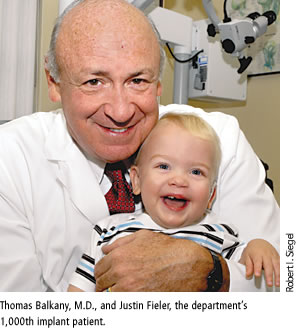 |
 |
 In January 18-month-old Justin Fieler underwent cochlear implant surgery that gave him the ability to hear for the first time since his birth. Justin also became a superstar in the Miller School’s Department of Otolaryngology as the 1,000th implant patient since Thomas Balkany, M.D., Hotchkiss Professor and chairman of the Department of Otolaryngology, established the Cochlear Implant Center in 1990. In January 18-month-old Justin Fieler underwent cochlear implant surgery that gave him the ability to hear for the first time since his birth. Justin also became a superstar in the Miller School’s Department of Otolaryngology as the 1,000th implant patient since Thomas Balkany, M.D., Hotchkiss Professor and chairman of the Department of Otolaryngology, established the Cochlear Implant Center in 1990.
“Every patient is a landmark at the Cochlear Implant Center because with each surgery a deaf person has an opportunity to enter the hearing world,” says Balkany. “We all feel that it’s a privilege to provide a service that impacts the lives of children and their families. It’s also an exciting time for cochlear implants—technology is improving rapidly and the field continues to evolve in ways that will help our patients.”
Those developments include an increase in bi-lateral cochlear implants, which currently require a separate device for each ear but in the future will require only one device that services both ears, says Balkany. In addition, cochlear implants are expected to become fully implantable in the next four to five years, and work is being done to adapt MP3 technology to improve the current cochlear implants.
Balkany, Annelle Hodges, Ph.D., associate professor of otolaryngology, and their team, which was recently joined by director of audiology David Fabry, Ph.D., can now offer their patients an increasing number of options for improving their hearing. Fabry, who has spent most of his career working with hearing aid technology, is now researching the convergence between cochlear implant and hearing aid signal processing strategies, which he says will “open up entirely new horizons for persons who suffer from hearing loss.”
|
 |
 |


